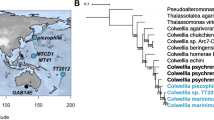Abstract
Many microorganisms from the deep-sea display high-pressure-adapted — also described as barophilic or piezophilic — growth characteristics. Phylogenetic studies have revealed that a large proportion of the barophilic bacteria currently in culture collections belong to a distinct subgroup of the genus Shewanella, referred to as the “barophile branch.“ Many of the basic properties of barophiles that enable their survival at extremes of pressure remain to be elucidated. However, several genes whose expression is regulated by pressure, or which appear to be critical to baroadaptation, have been uncovered. One such operon, whose presence appears to be restricted to the “barophile branch,” has been identifed in DNA samples obtained from sediments recovered in the deepest ocean trench. In the case of another set of pressure-regulated genes, regulatory elements required for pressure signaling have been uncovered. The nature and regulation of these genes is discussed.
Similar content being viewed by others
Author information
Authors and Affiliations
Additional information
Received: February 19, 1997 / Accepted: March 3, 1997
Rights and permissions
About this article
Cite this article
Kato, C., Bartlett, D. The molecular biology of barophilic bacteria . Extremophiles 1, 111–116 (1997). https://doi.org/10.1007/s007920050023
Issue Date:
DOI: https://doi.org/10.1007/s007920050023




